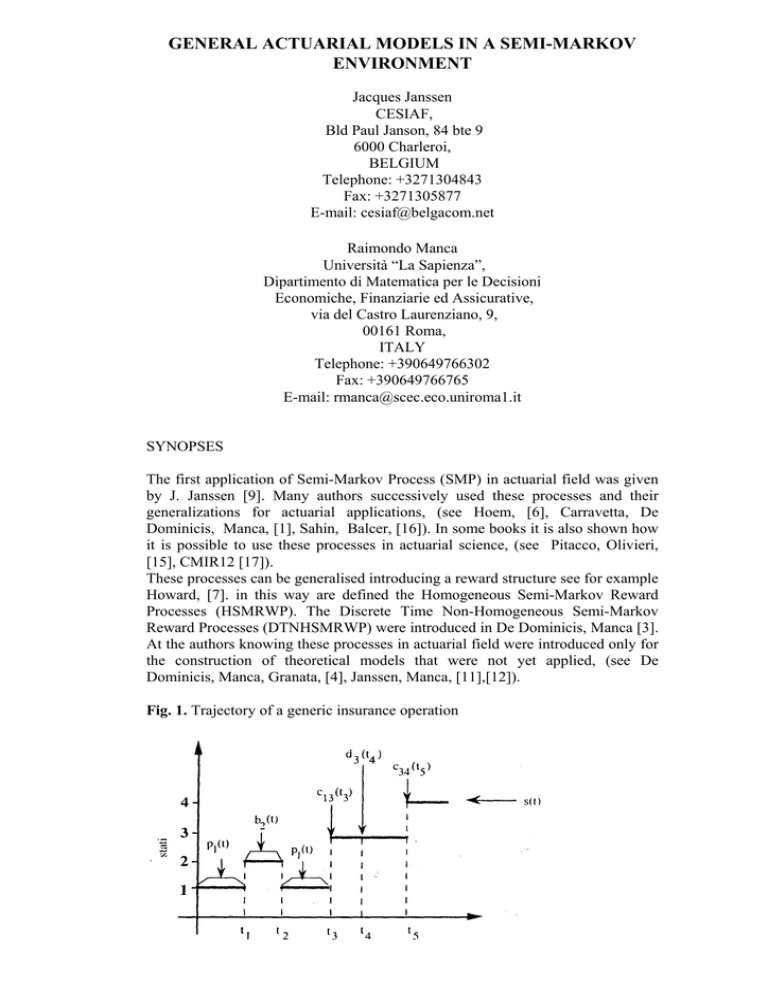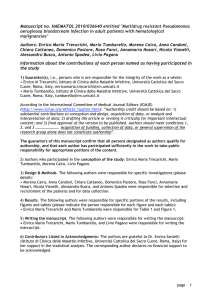
GENERAL ACTUARIAL MODELS IN A SEMI-MARKOV
ENVIRONMENT
Jacques Janssen
CESIAF,
Bld Paul Janson, 84 bte 9
6000 Charleroi,
BELGIUM
Telephone: +3271304843
Fax: +3271305877
E-mail: [email protected]
Raimondo Manca
Università “La Sapienza”,
Dipartimento di Matematica per le Decisioni
Economiche, Finanziarie ed Assicurative,
via del Castro Laurenziano, 9,
00161 Roma,
ITALY
Telephone: +390649766302
Fax: +390649766765
E-mail: [email protected]
SYNOPSES
The first application of Semi-Markov Process (SMP) in actuarial field was given
by J. Janssen [9]. Many authors successively used these processes and their
generalizations for actuarial applications, (see Hoem, [6], Carravetta, De
Dominicis, Manca, [1], Sahin, Balcer, [16]). In some books it is also shown how
it is possible to use these processes in actuarial science, (see Pitacco, Olivieri,
[15], CMIR12 [17]).
These processes can be generalised introducing a reward structure see for example
Howard, [7]. in this way are defined the Homogeneous Semi-Markov Reward
Processes (HSMRWP). The Discrete Time Non-Homogeneous Semi-Markov
Reward Processes (DTNHSMRWP) were introduced in De Dominicis, Manca [3].
At the authors knowing these processes in actuarial field were introduced only for
the construction of theoretical models that were not yet applied, (see De
Dominicis, Manca, Granata, [4], Janssen, Manca, [11],[12]).
Fig. 1. Trajectory of a generic insurance operation
The applications proposed in those papers were in pension and in health
insurance. The authors are also working on the construction of a model for non
life insurance, more precisely in credit risk environment, using non-homogeneous
semi-Markov processes.
It is to outline that the models that are obtained for all actuarial applications that
the authors constructed are similar. They bring to SMRWP in which it is possible
to consider simultaneousely the future development of the state system and its
financial evolution.
The figure 1 is reported from Pitacco, Olivieri, [15].
The two authors explain that this can be considered a graph that gives a trajectory
of the stochastic process that describes an insurance operation.
Fig. 2. Trajectory of a SMP.
The figure 2 gives the trajectory of a possible evolution of a semi-Markov process
(see Janssen, [10] ).
It is evident that they have the same behaviour. And this can explain because the
actuarial models, in the authors opinion, are strictly connected to semi-Markov
processes.
Fig. 3. m states model for insurance operation.
In this light and after many experiences, the authors think that it is possible to face
any kind of actuarial problem by means of a model based on SMP. In this paper a
semi-Markov reward model that can afford a general actuarial problem will be
presented.
The graph describing this model is reported in figure 3.
It is to precise that the arcs are weighted and their weights can rpresent the change state
probabilities and the rewards that are paid in the case of change state Furthermore, also
the nodes, that represent the model states, are weighted and their weights represent the
reward paid or received remaining in the state. All rewards can be fixed or can change in
the time evolution of the model.
The formula of the evolution equation of a SMRWP that can take in account
simultaneusely all the aspects of a general actuarial problem will be given.
That formula is able to take in account all the possibility that can happen in an
actuarial problem.
In the paper will be explained how the formula and the related graph will change
in function of the actuarial problem that is to face.
REFERENCES
[1] Carravetta M., R. De Dominicis, R. Manca, “Semimarkov process in social
security problems”, in Cahiers du C.E.R.O., 1981.
[2] De Dominicis R., J. Janssen, An algorithmic approach to non-homogeneous
semi-Markov processes. Insurance: Mathematics and Economics 3, 157-165,
1984
[3] De Dominicis R., R. Manca, “Some new results on the transient behaviour of
semi-Markov reward processes”, Methods of Operations Research, 387-397
Verlag Anton Hain, 1985.
[4] De Dominicis R., R. Manca, M. Granata, “The Dynamics of Pension Funds in
a Stochastic Environment”, Scandinavian Actuarial Journal, 1992.
[5] Haberman S., E. Pitacco. Actuarial model for disability insurance. Chapman
& Hall. 1999.
[6] Hoem J.M., “Inhomogeneous semi-Markov processes, select actuarial tables,
and duration-dependence in demography”, in T.N.E. Greville, Population,
Dynamics, Academic Press, 251-296, 1972.
[7] Howard R., Dynamic probabilistic systems, vol II, Wiley, 1972.
[8] Iosifescu Manu A., “Non homogeneous semi-Markov processes”, Stud. Lere.
Mat. 24, 529-533, 1972
[9] Janssen J., “Application des processus semi-markoviens à un probléme
d’invalidité”, Bulletin de l”Association Royale des Actuaries Belges, 63, 35-52,
1966.
[10] Janssen J., “Semimarkov processes and applications in risk and queueing
theories”, Quaderni dell’Istituto di Matematica della Facoltà di Economia e
Commercio dell’Università di Napoli, n. 35, 1983.
[11] Janssen J., R. Manca, “A Realistic Non-Homogeneous Stochastic pension
Fund Model on Scenario Basis”, Scandinavian Actuarial Journal, 2, 113-137,
1997.
[12] Janssen J., R. Manca, “Non-homogeneous semi-Markov reward process for
the management of health insurance models”, Proceedings ASTIN Washington
(2001).
[13] Levy P., Processus semi-Markoviens. Proceedings of International Congress
of Mathematics (Amsterdam) 1954
[14] H. Mine and S. Osaki, Markovian decision processes, Elsevier, 1970.
[15] Pitacco E., A. Olivieri, Introduzione alla teoria attuariale delle assicurazioni
di persone, Quaderni dell’UMI, 42, Pitagora Editrice, Bologna, 1997.
[16] Sahin I., Y. Balcer, “Stochastic models for a pensionable service”,
Operations Research, 27, 888-903, 1979.
[17] CMIR12 (Continuous Mortality Investigation Report, number 12). The
analysis of permanent health insurance data. The Institute of Actuaries and the
Faculty of Actuaries, 1991



